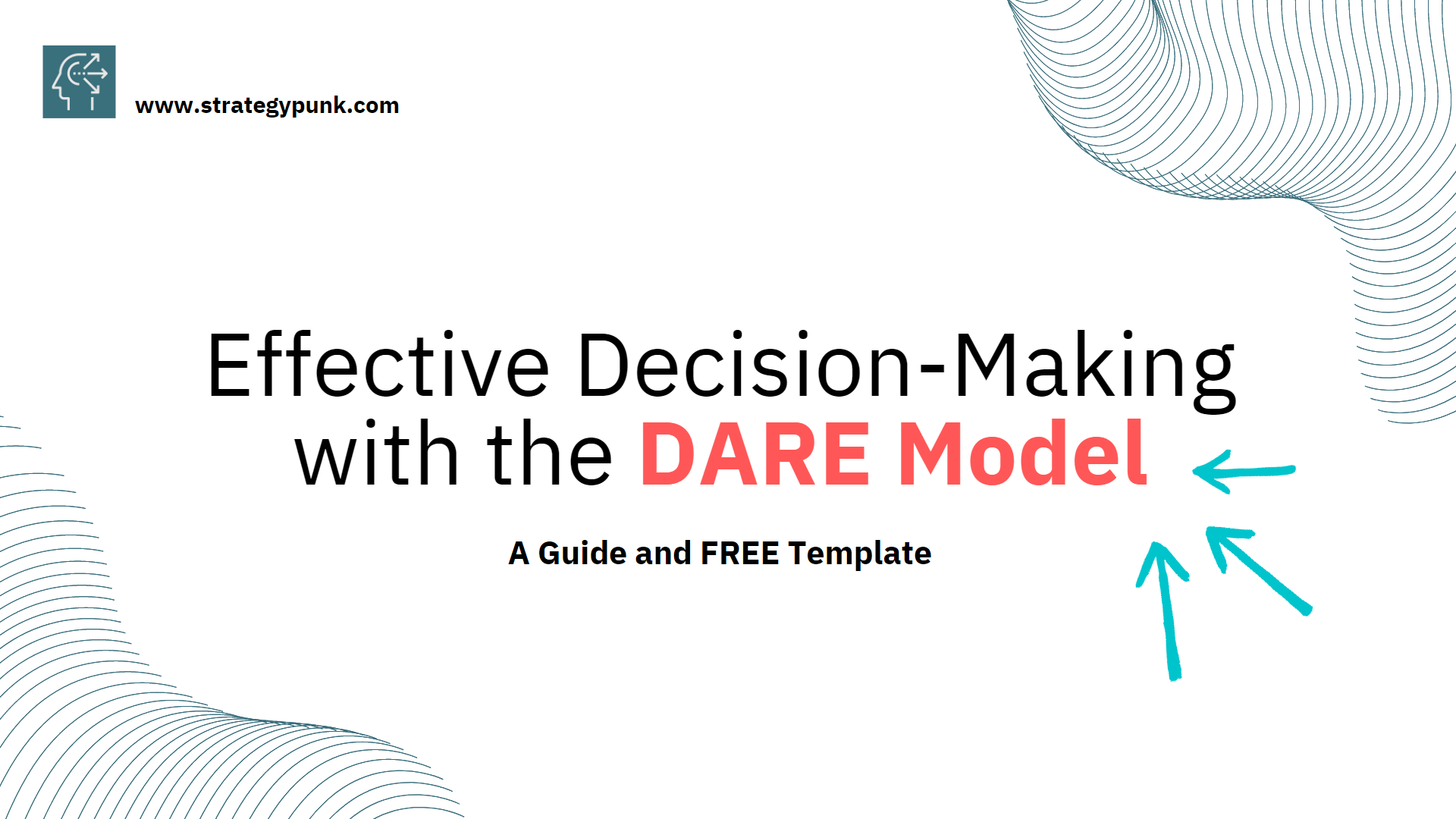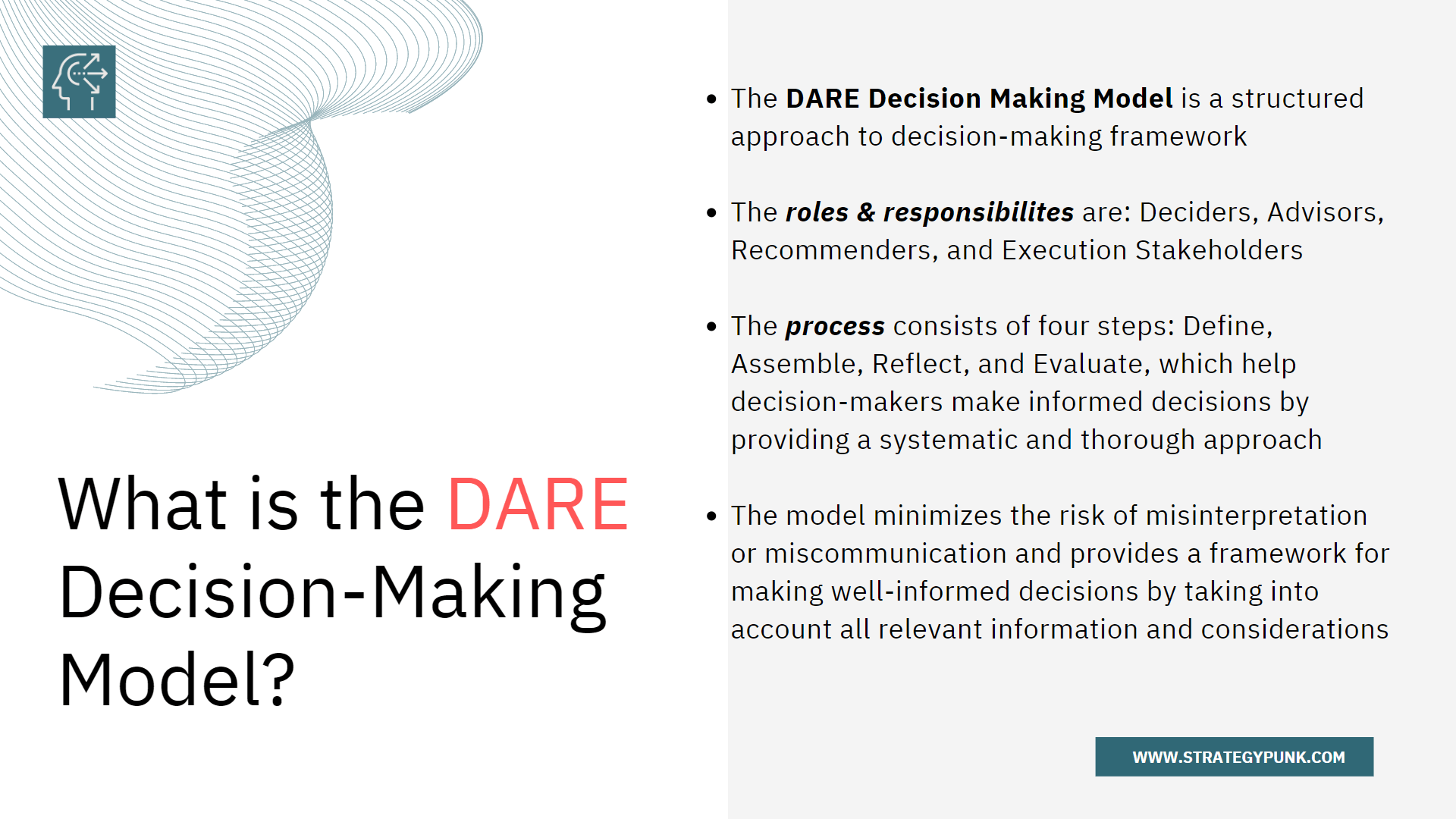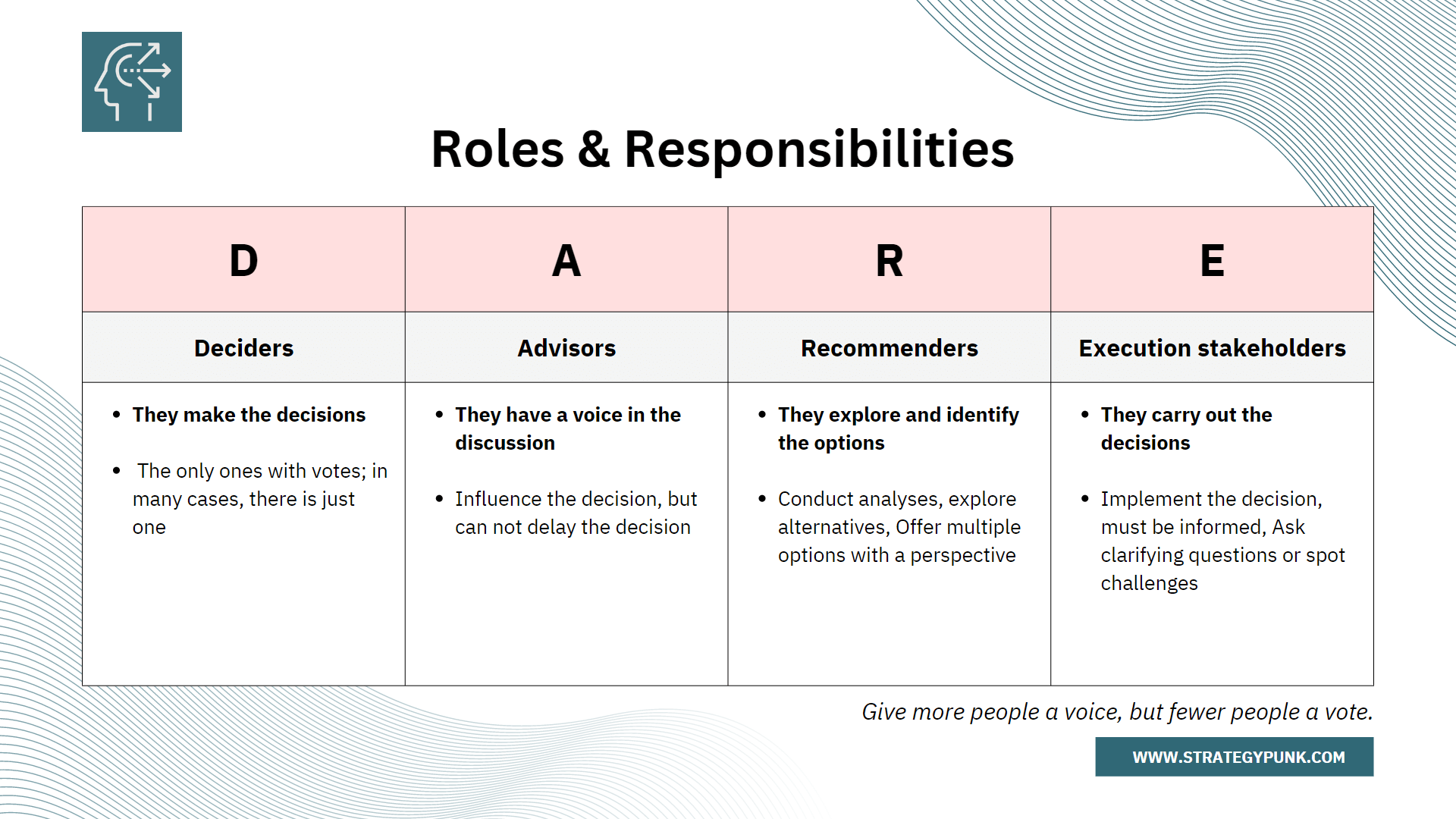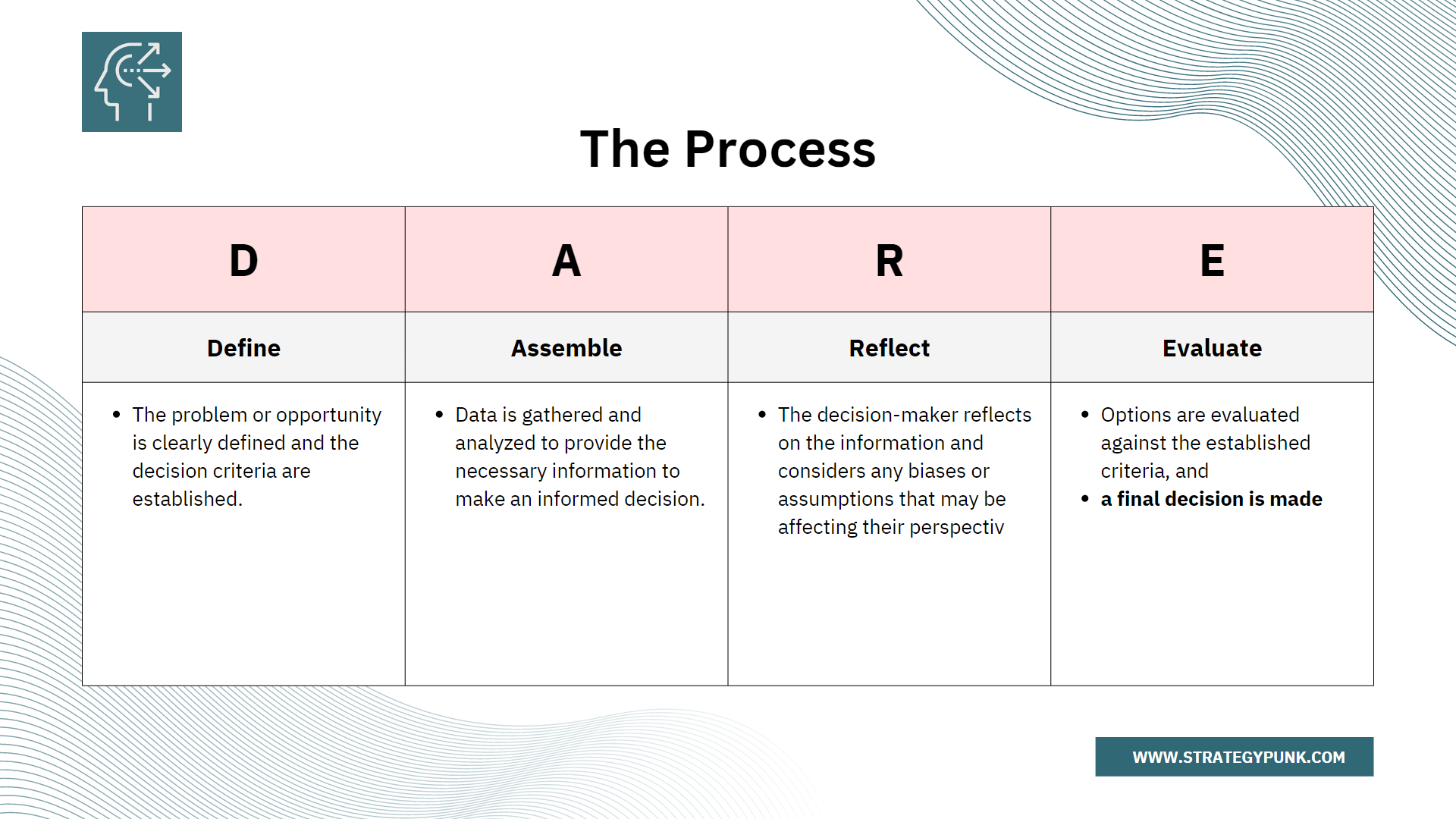Master Effective Decision-Making with the DARE Model: A Guide and Template
Discover the DARE Decision-Making Model and learn how to make informed choices in any situation. This comprehensive guide covers the key steps of the DARE model and provides practical tips for effective decision-making. Read on to elevate your decision-making skills!

Making effective decisions is a critical skill in both personal and professional life.
The DARE Decision Making Model is a framework that provides a structured approach to making well-informed decisions.
The acronym DARE stands for Decide, Analyze, Reflect, and Execute.

It encourages us to pause, assess our options, and consider the consequences of our actions. The model can help us reduce the risk of making bad decisions and increase the likelihood of making good decisions.
This simple yet powerful tool provides a structured approach to decision-making, ensuring that all relevant factors and stakeholders are considered and a well-informed conclusion is reached.
What are the roles in the DARE decision-making model?

The roles & responsibilities are
- Deciders
- Advisors
- Recommenders
- Execution Stakeholders
Decision-makers typically use the model to make the final decision. Advisors provide expert opinions and recommendations. Recommenders gather and analyze data. Execution Stakeholders are responsible for implementing the decision and ensuring its successful outcome.
How to use the DARE decision-making model?

The process of the DARE Decision Making Model is a structured approach to decision-making that involves four key steps:
- Define
- Assemble
- Reflect
- Evaluate.
It is typically used by Deciders, who are individuals or groups responsible for making the final d
The problem or opportunity is clearly defined in the Define step, and the decision criteria are established.
Data is gathered and analyzed in the assembly step to provide the necessary information to make an informed decision.
In the Reflect step, the decision-maker considers the information and any biases or assumptions affecting their perspective.
In the evaluation step, options are evaluated against the established criteria, and a final decision is made.
Advisors play an essential role in the DARE Model by providing expert opinions and recommendations. These individuals bring knowledge and experience to the decision-making process and can help ensure that all relevant information is considered.
Recommenders are responsible for gathering and analyzing data. They provide a comprehensive view of the situation and help to ensure that the information used to make a decision is accurate and relevant.
Execution Stakeholders are responsible for implementing the decision and ensuring its successful outcome. These individuals or groups work to ensure the decision is adequately executed and any necessary follow-up actions are taken.
Benefits of Using the DARE Decision-Making Model
The DARE Decision Making Model offers several benefits, including increased clarity, improved decision-making, and accountability.
One key benefit of using the DARE Decision Making Model is increased clarity. The model encourages us to analyze our options, consider the potential consequences of each option, and reflect on our decisions before acting. This helps us make decisions with a clear understanding of the possible outcomes.
Using the DARE Decision-Making Model also helps us make better decisions. The model encourages us to consider the pros and cons of each option, weigh the potential outcomes, and make an informed decision. This helps us reduce the risk of making bad decisions and increase the likelihood of making good decisions.
Finally, the DARE Decision Making Model helps us become more accountable for our decisions. By taking the time to consider our options and reflect on our findings, we are more likely to take ownership of our choices and be accountable for the results.
Implementing the DARE Decision-Making Model
You can use several best practices to ensure you get the most out of the DARE Decision-Making Model.
- Identify the Problem: The first step is to identify the problem or decision that needs to be made. This is the stage where you will determine what options are available and identify the potential outcomes of each option.
- Gather and Analyze Data: The next step is to gather and analyze data to help you make an informed decision. This step is crucial because it lets you understand each option's consequences and potential impact.
- Take Time to Reflect: The third step is to take the time to think through the decision and consider the implications of each option. This is the stage where you will assess the pros and cons of each option and make a conscious decision.
- Make a Plan of Action: The fourth step is to develop a plan of action. This is the stage where you will determine how to act on the decision and implement your plan.
- Monitor the Results: Finally, the fifth step is to monitor the results of your decision. This is the stage where you will assess your decision and adjust as needed.
Wrapping Up and Conclusion
The DARE Decision Model is a structured approach to decision-making that emphasizes defining the problem, gathering data, reflecting on information, and evaluating options before making a final decision.
It is designed to minimize the risk of misinterpretation or miscommunication while providing a framework for making informed decisions. The model's four steps help decision-makers make well-informed decisions by providing a systematic and thorough approach to the decision-making process.
The four steps of the DARE Decision Model are Define, Assemble, Reflect, and Evaluate. The problem or opportunity is clearly defined in the Define step, and the decision criteria are established. Data is gathered and analyzed in the assembly step to provide the necessary information to make an informed decision. In the Reflect step, the decision-maker reflects on the information and considers any biases or assumptions affecting their perspective. In the evaluation step, options are evaluated against the established criteria, and a final decision is made.
The DARE Decision Model provides a structured approach to decision-making that helps ensure that decisions are well-informed and that all relevant information is considered.
DARE Model: Template
FREE Template in PDF, PowerPoint and Google Slides format
Download our FREE template now and experience a structured and systematic approach to problem-solving that minimizes the risk of misinterpretation or miscommunication while maximizing the chances of success.
Start making more intelligent decisions today!






